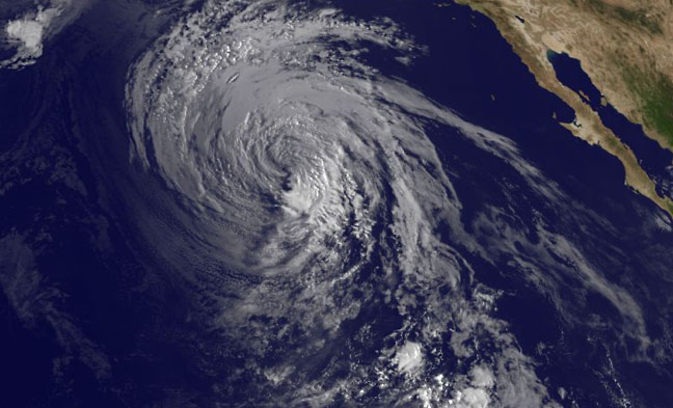NASA Sees a Weaker Tropical Storm Marie

This image of Tropical Storm Marie was captured by NOAA's GOES-West satellite on August 28 at 11 a.m. EDT and showed the strongest storms were south of the center. Image Credit: NASA/NOAA GOES Project
NOAA's GOES-West satellite captured an image of Marie on August 28 at 11 a.m. EDT. Bands of thunderstorms circled the storm especially to the north.
The National Hurricane Center noted that Marie has continued to produce a small area of convection (rising air that forms the thunderstorms that make up Marie) south and east of the center during some hours on the morning of August 28. The GOES image was created by the NASA/NOAA GOES Project at NASA's Goddard Space Flight Center in Greenbelt, Maryland.
Infrared data, such as that from the Atmospheric Infrared Sounder instrument aboard NASA's Aqua satellite showed that cloud tops had warmed.
Warming cloud tops means that the strength in the uplift of air (that pushes cloud tops higher into the colder levels of the atmosphere) has weakened, and clouds are not getting as high as they did before. The higher the thunderstorms, the stronger they usually are, but Marie's are dropping in height.
Marie is not able to generate strong thunderstorms because it has moved over cooler waters. Sea surface temperatures of at least 80 F (26.6 C) are needed to maintain a hurricane's strength. Marie is in waters as cool as 22C (71.6F).
At 11 a.m. EDT (1500 UTC) Marie's maximum sustained winds were down to 45 mph (75 kph) and weakening. Marie was centered near latitude 25.4 north and longitude 128.9 west, about 865 miles (1,395 km) west of Punta Eugenia, Mexico. Marie is moving northwest at 15 mph (24 kph).
The NHC expects Marie should become post-tropical by tonight, August 28. Meanwhile Marie continues kicking up rough surf.
Large southerly swells affecting much of the west coast of the Baja California peninsula and the coast of southern California will gradually subside through Friday, August 29. These swells could still produce life-threatening surf and rip currents, as well as minor coastal flooding around the time of high tide.
Text credit: Rob Gutro
NASA's Goddard Space Flight Center
Media Contact
More Information:
http://www.nasa.gov/content/goddard/marie-eastern-pacific/All latest news from the category: Earth Sciences
Earth Sciences (also referred to as Geosciences), which deals with basic issues surrounding our planet, plays a vital role in the area of energy and raw materials supply.
Earth Sciences comprises subjects such as geology, geography, geological informatics, paleontology, mineralogy, petrography, crystallography, geophysics, geodesy, glaciology, cartography, photogrammetry, meteorology and seismology, early-warning systems, earthquake research and polar research.
Newest articles

Properties of new materials for microchips
… can now be measured well. Reseachers of Delft University of Technology demonstrated measuring performance properties of ultrathin silicon membranes. Making ever smaller and more powerful chips requires new ultrathin…

Floating solar’s potential
… to support sustainable development by addressing climate, water, and energy goals holistically. A new study published this week in Nature Energy raises the potential for floating solar photovoltaics (FPV)…

Skyrmions move at record speeds
… a step towards the computing of the future. An international research team led by scientists from the CNRS1 has discovered that the magnetic nanobubbles2 known as skyrmions can be…




















